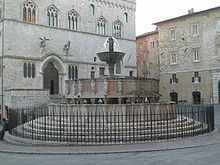Fontana Maggiore
The Fontana Maggiore , a well decorated with reliefs in the Umbrian city of Perugia is probably the most famous of all medieval fountains in Italy.
It was built between 1277 and 1278 and provided with sculptures by the most important sculptors in Italy at the time, father Niccolò Pisano and son Giovanni Pisano . The fountain was the end point of a system of several aqueducts that led the water from Monte Paccino, three kilometers away, through lead pipes to the city hill. It was decided to build in 1254, which lasted two decades because the high-lying well caused technical problems.
The fountain has a three-storey structure, the two lower parts are made of marble . The most expansive pool has the floor plan of a 25-corner. The second, middle shell is supported by 36 columns on the edge and a central column. It is a 24-gon, with every other corner drawn inwards. On the uppermost, bronze bowl stand three young graces who together carry a water-giving amphora .
The numerous relief panels and figures of the fountain are based on a comprehensive program: on the lowest level, life on earth is depicted in three thematic cycles on 50 fields: human history from the Old Testament , the monthly work together with the Artes mechanicae - the manual work Working - and the seven liberal arts ( Artes liberales ) with the embodiment of philosophy .
The upper twelve-sided shell is supported by 24 columns. Above each stand 24 three-quarter-round figures, which alternate on the wall of the fountain with fields of red marble. They stand for a higher-ranking world: personifications of Perugia and Rome, angels and patron saints , biblical, mythological and historical figures. The diversity of the image program was unprecedented in the history of public fountains, and not just in Italy.
Worn and damaged by the weather and everyday use, the complex has been restored and supplemented several times. Instead of using the steps, people originally approached the fountain via a brick ramp. The pillars of the inner ring were originally not made of travertine, but of red stone like the fields of the wall above. Some of the reliefs are so washed out that a reliable stylistic assignment to one of the two Pisani is not possible. The fountain was last extensively restored in 1948.
The sophisticated iconography , the artistic rank and the technical effort show that the fountain should serve more than just everyday use. Rather, it was at the same time the "sovereign state symbol" of the city, which in 1198 had broken away from imperial authority and placed under the protection of the Pope in Rome, but nevertheless aspired to be largely independent as a trading city (similar to the Tuscan city-states).
literature
- Kathrin Hoffmann-Curtius : The program of the Fontana Maggiore in Perugia (= Bonn contributions to art history. Vol. 10, ISSN 0068-0036 ). Rheinland-Verlag, Düsseldorf 1968 (at the same time: Bonn, University, dissertation 1965).
- Klaus Zimmermanns: Umbria. A landscape in the heart of Italy. (= DuMont documents. DuMont art travel guide ). DuMont, Cologne 1987, ISBN 3-7701-1684-4 , p. 70, fig. 23, 24, color plate 3.
- Georg Kauffmann : Reclam's Art Guide Italy, Vol. IV, Emilia-Romagna-Marken-Umbria , Stuttgart 1971, pp. 440–446.
swell
- ↑ Kauffmann, p. 446
Web links
Coordinates: 43 ° 6 ′ 43.6 ″ N , 12 ° 23 ′ 19.7 ″ E

